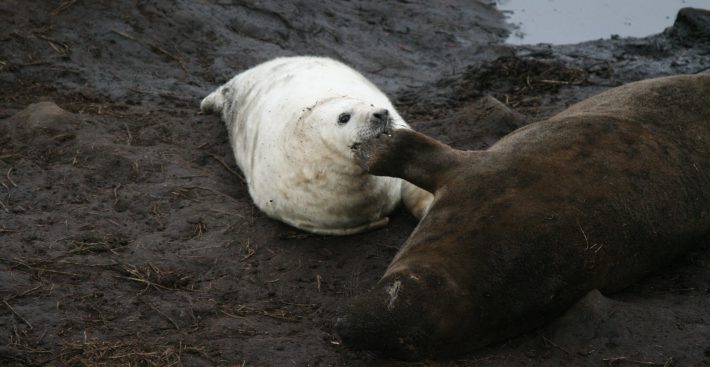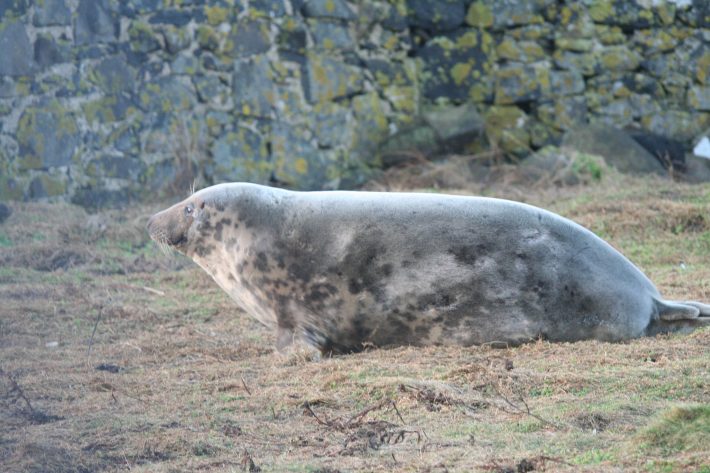Managing energy balance through lactation
Durham University press release.
Recently published research in Journal of Animal Ecology explores how grey seal mothers maximize their chances of successfully rearing pups during an ‘energetic fast’ where they rely on stored reserves to feed pups.

Managing energy inputs and outputs is central to all animal life. Often these trade-offs can matter more when provisioning dependent offspring with the energy they need to grow and develop. Among mammals, mothers are typically the ones who have to spend tremendous amounts of energy on their offspring, particularly in providing milk.
An extreme example of these demands on the mother are seen in the true seals (phocids), such as the grey seal. Even though a grey seal mother fasts during pup rearing, relying on stored reserves accumulated at sea, she can supply her pup with up to 18,000 kcal in energy rich milk every day of the 18 days needed to raise her pup to independence.
Coping with this extreme energy output requires grey seal mothers to carefully balance how they use their finite resources so that their offspring receives as much as possible, while still keeping enough to maintain themselves in the process. Effectively, seal mothers are walking an energy tight rope. So, how do grey seal mothers achieve this balancing act?
We can examine how a mother allocates her reserves between background energy demands, such as those relating to metabolic rate or milk production, and energy spent on daily activity and other processes. Given that grey seal mothers do not feed while raising their pups, we would expect mothers who are able to spend less on daily activities will be able to direct more to their pups.
Our approach used remotely detected changes in seal heart rates (as a measure of energy expenditure) to examine this trade-off. We attached heart rate monitors to known mothers at the Isle of May (Scotland) in 3 successive years. Heart rate data from these monitors provided us with daily energy expenditure (mean daily heart rate) and background energy expenditures (minimum mean daily heart rate) for 52 seals.
We were interested in how individuals balanced mean and minimum heart rate while raising their pups, what limits there were to this trade-off, and how local environment (such as weather) might affect the trade-off.

What did we find?
- As we expected grey seal mothers typically exhibit what is known as ‘energy compensation’ during lactation. This means that within each breeding season, during periods of high activity demands individuals decreased the amount of energy used for background costs and vice versa, resulting in an overall cap in daily energy expenditure during this period of high energy expenditure while fasting.
- Mothers who failed to balance energy expenditures properly were more likely to end lactation earlier than expected. While we could not directly measure the future success of pups, this lack of adequate balancing is likely to result in a negative outcome for pups. A mother who spends less time nursing her pup is likely to produce a smaller pup, and this reduces the chances of the pup surviving to adulthood.
- We also found that individual mothers tended to show similar patterns of energy balance across years, indicating that these strategies may be individualistic and repeatable.
- Our multi-seasonal data also indicated that environmental stressors, in particular warmer weather, can influence how well mothers are able to balance their energy demands. In a time of increasingly unpredictable climate these findings suggest that more mothers may struggle to adequately manage their energy balance successfully under extreme environmental conditions.
Importance: The approach we use here can be used more widely as metrics to uncover how different stresses on wild animals, including human induced changes to their environment, impact their ability to successfully manage their energy balance which is critical to breeding success.
You can read the full article for free here:
, , , . Energetic limits: Defining the bounds and trade‐offs of successful energy management in a capital breeder. J Anim Ecol. 2020; 00: 1– 12. https://doi.org/10.1111/1365-2656.13312
Like what we stand for?
Support our mission and help develop the next generation of ecologists by donating to the British Ecological Society.